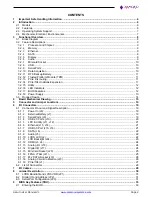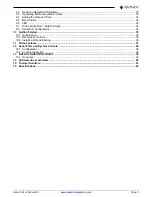
Saturn User Manual V1
Page 5
Overvoltage on analog input
– If a voltage applied to an analog input exceeds the design specification of the
board, the input multiplexor and/or parts behind it can be damaged. Most of our boards will withstand an erroneous
connection of up to
35V on the analog inputs, even when the board is powered off, but not all boards, and not in
all conditions.
Overvoltage on analog output
– If an analog output is accidentally connected to another output signal or a power
supply voltage, the output can be damaged. On most of our boards, a short circuit to ground on an analog output
will not cause trouble.
Overvoltage on digital I/O line
– If a digital I/O signal is connected to a voltage above the maximum specified
voltage, the digital circuitry can be damaged. On most of our boards the acceptable range of voltages connected to
digital I/O signals is 0-5V, and they can withstand about 0.5V beyond that (-0.5 to 5.5V) before being damaged.
However logic signals at 12V and even 24V are common, and if one of these is connected to a 5V logic chip, the
chip will be damaged, and the damage could even extend past that chip to others in the circuit.
Bent connector pins
– This type of problem is often only a cosmetic issue and is easily fixed by bending the pins
back to their proper shape one at a time with needle-nose pliers. The most common cause of bent connector pins
is when a PC/104 board is pulled off the stack by rocking it back and forth left to right, from one end of the connector
to the other. As the board is rocked back and forth it pulls out suddenly, and the pins at the end get bent significantly.
The same situation can occur when pulling a ribbon cable off of a pin header. If the pins are bent too severely,
bending them back can cause them to weaken unacceptably or even break, and the connector must be replaced.




































